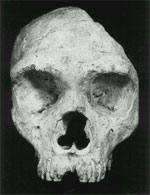Species apart
 there is no trace of Neanderthals lurking anywhere in our family tree, says a group of German and us scientists from the Zoological Institute University of Munich and Pennsylvania State University. The scientists, led by Svante Paabo of the University of Munich in Germany, made a groundbreaking claim in the journal Cell (July 11) that there was no genetic similarity between the ancient Neanderthals and modern human beings living anywhere in the world. The researchers say that the moderns have instead descended from ancestors who lived in Africa relatively recently.
there is no trace of Neanderthals lurking anywhere in our family tree, says a group of German and us scientists from the Zoological Institute University of Munich and Pennsylvania State University. The scientists, led by Svante Paabo of the University of Munich in Germany, made a groundbreaking claim in the journal Cell (July 11) that there was no genetic similarity between the ancient Neanderthals and modern human beings living anywhere in the world. The researchers say that the moderns have instead descended from ancestors who lived in Africa relatively recently.
The claim follows the analyses of the Neanderthal dna by the researchers who were the first to extract genetic material from a fragment of human bone between 30,000 and 100,000 years old, dug out of a quarry in Dusseldorf in 1856.This claim is likely to fuel the debate over human origins that has been raging on for the past 10 years.
"This is the first genetic information we have from an extinct form of human. It indicates that we are all recent immigrants from Africa," Paabo said. The resear-chers compared the Neanderthal dna with that of 994 human lineages including Africans, Euro-peans, Asians, native Americans and Pacific Islanders. They found that there were about 27 differences between the Neanderthal dna and modern human dna from anywhere in the world.
"It is a brilliant, innovative piece of work. I just doubt that it can be faulted on technical grounds," said Milford H Wolpoff, professor of anthropology at the University of Michigan, although he emphasised that the arguments will go on before the theory is accepted in toto. However, it lends weight to a theory known as 'out of Africa' which holds that Homo sapiens had evolved from a common ancestor in Africa about 200,000 years ago.
"This is obviously a fantastic achievement," said Chris Stringer, an expert on Neanderthals at the Museum of Natural History in London. Many anthropologists had earlier tried to extract dna from Neanderthal bones without success. "Clearly, it is a coup," said Maryellen Ruvolo, an anthropologist at the Harvard University.
The Neanderthals were large, thick-boned individuals with heavy brows and a brain case as large as that of modern humans, but stacked behind the face instead of being on top of it. They lived in western Asia and Europe 300,000 years ago. For the later part of the period, they coexisted with modern humans but the relationship between the two groups, whether fraternal or genocidal, has been debated ever since the first Neanderthal was discovered.
The interpretation of the Neander-thal mitochondrial data may be open to debate on the dating. "Deriving these dates involves making a lot of supposition about the neutrality of the mitochondrial genome and the speed of accretion of new changes," said Ian Tattersall, a paleontologist at the American Museum of Natural History at Manhattan. Ruvolo said that the Munich team's methods seemed sound and their theory - as fantastic as the landing of the Pathfinder on Mars, according to scientists - is likely to be accepted. "There could be minor quibbles over the dates but the overall properties of the tree won't change," she confirmed.
Related Content
- Order of the Supreme Court regarding protection of Great Indian Bustard (GIB) and Lesser Florican, 21/03/2024
- Order of the National Green Tribunal regarding policy for cutting of trees and protection of trees, Punjab, 28/07/2023
- Order of the National Green Tribunal regarding illegal sand mining in Madhya Pradesh, Uttar Pradesh and Rajasthan, 06/02/2023
- Thresholds of catastrophe in the Earth system
- Traditional knowledge of wild edible fruits in southern Africa: A comparative use patterns in Namibia and Zimbabwe
- Overflowing cities: The State of the World's Toilets 2016
